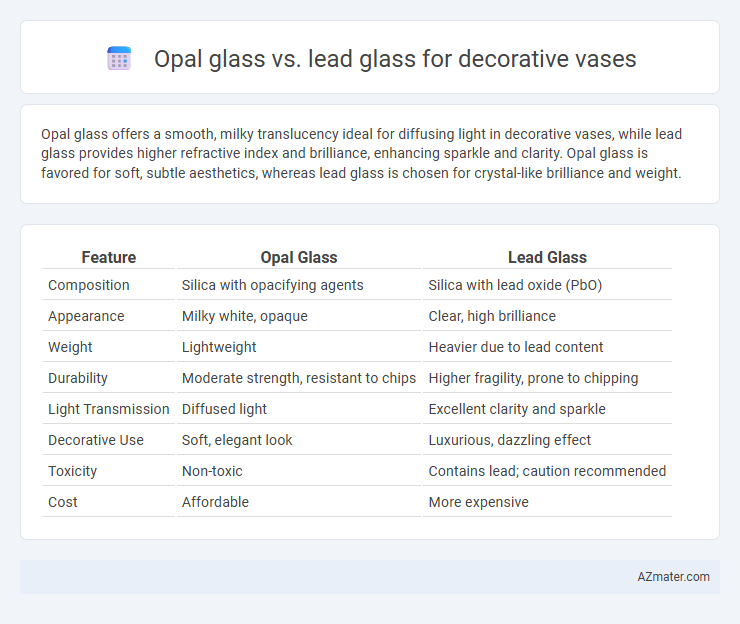Opal glass offers a smooth, milky translucency ideal for diffusing light in decorative vases, while lead glass provides higher refractive index and brilliance, enhancing sparkle and clarity. Opal glass is favored for soft, subtle aesthetics, whereas lead glass is chosen for crystal-like brilliance and weight.
Table of Comparison
| Feature | Opal Glass | Lead Glass |
|---|---|---|
| Composition | Silica with opacifying agents | Silica with lead oxide (PbO) |
| Appearance | Milky white, opaque | Clear, high brilliance |
| Weight | Lightweight | Heavier due to lead content |
| Durability | Moderate strength, resistant to chips | Higher fragility, prone to chipping |
| Light Transmission | Diffused light | Excellent clarity and sparkle |
| Decorative Use | Soft, elegant look | Luxurious, dazzling effect |
| Toxicity | Non-toxic | Contains lead; caution recommended |
| Cost | Affordable | More expensive |
Introduction to Decorative Vase Materials
Opal glass features a milky, opaque white appearance achieved by adding bone ash or tin oxide, offering a smooth, elegant finish ideal for decorative vases. Lead glass, containing 24-30% lead oxide, delivers exceptional clarity and brilliance with a heavier weight and enhanced refractive index, making it prized for high-end ornamental vases. Both materials provide distinct aesthetic qualities and durability, with opal glass leaning towards subtle, diffuse light effects and lead glass emphasizing sparkle and luxury in decorative vase craftsmanship.
What Is Opal Glass?
Opal glass is a type of glass characterized by its milky, opaque white appearance achieved through the addition of opacifiers like tin oxide or bone ash during manufacturing. Unlike lead glass, which contains high levels of lead oxide for increased brilliance and weight, opal glass offers a softer, diffused light effect ideal for decorative vases. Its durability and unique translucency make opal glass a popular choice for artistic and ornamental glassware that requires both aesthetic appeal and functional strength.
What Is Lead Glass?
Lead glass, also known as lead crystal, contains a high percentage of lead oxide, typically between 24% and 30%, which enhances its weight, brilliance, and refractive index, making it highly prized for decorative vases. Its superior clarity and sparkling effect allow intricate designs and patterns to stand out more vividly compared to opal glass, which is opaque and has a milky, soft appearance due to the addition of opacifiers. Lead glass is heavier and more fragile, offering a luxurious aesthetic but requiring careful handling to preserve its pristine condition in decorative applications.
Visual Differences: Opal Glass vs Lead Glass
Opal glass features a milky, translucent appearance that diffuses light softly, creating a smooth, matte-like finish ideal for subtle elegance in decorative vases. Lead glass, known for its high refractive index, produces brilliant sparkle and clarity with pronounced light refraction, resulting in a glossy, crystalline effect that enhances intricate designs. The visual distinction lies in opal glass's muted, frosted look compared to lead glass's vibrant, sparkling brilliance.
Durability and Strength Comparison
Opal glass, recognized for its milky translucence, offers strong resistance to thermal shock and moderate durability suitable for artistic decorative vases. Lead glass, containing high lead oxide content, exhibits superior density and exceptional strength, providing enhanced durability and weight that contribute to a luxurious feel and improved impact resistance. When comparing durability and strength, lead glass outperforms opal glass in terms of hardness and shatter resistance, making it a preferred choice for high-end decorative vases requiring both elegance and robustness.
Decorative Appeal and Aesthetic Value
Opal glass offers a smooth, milky translucence that diffuses light softly, creating a subtle, elegant glow ideal for modern decorative vases. Lead glass, enriched with lead oxide, provides exceptional clarity and brilliance, enhancing intricate designs with a high refractive index and sparkling radiance. The choice between opal and lead glass depends on desired aesthetic effects: opal glass suits understated, diffused beauty while lead glass excels in vivid, luminous decoration.
Safety and Environmental Considerations
Opal glass, made from silica and natural minerals, is free of lead and poses fewer health risks during production and use, making it a safer choice for decorative vases in homes, especially where children are present. Lead glass contains significant amounts of lead oxide, enhancing clarity and weight but raising concerns about lead exposure and environmental contamination during manufacturing and disposal. Choosing opal glass reduces the risk of toxic lead leaching and aligns with eco-friendly practices focused on minimizing hazardous waste and promoting sustainable materials.
Pricing and Market Availability
Opal glass typically costs less than lead glass due to its lower production complexity and non-toxic composition, making it more accessible for decorative vases. Lead glass, prized for its clarity and weight, commands higher prices and is less widely available in the market, often reserved for premium or luxury decorative items. Market availability favors opal glass with greater mass production and variety in design, while lead glass vases are found mainly in specialty stores or high-end retailers.
Ideal Uses in Decorative Vase Design
Opal glass offers a translucent, milky appearance ideal for decorative vases that require soft, diffused light effects and a modern aesthetic. Lead glass, with its high refractive index and brilliance, is perfect for vases designed to showcase intricate cuts and enhance light reflection, adding elegance and luxury to display pieces. Both materials suit decorative vase design, but opal glass emphasizes subtle sophistication, while lead glass prioritizes sparkle and visual impact.
Choosing the Right Glass for Your Vase
Opal glass offers a translucent, milky white appearance that diffuses light softly, making it ideal for vases aiming for a subtle, elegant glow. Lead glass, rich in lead oxide, provides greater clarity and brilliance with a heavier weight, enhancing the vase's sparkle and luxury appeal. Choosing between opal and lead glass depends on the desired aesthetic effect and budget, with opal glass suited for understated decor and lead glass preferred for high-end, dazzling decorative vases.

Infographic: Opal glass vs Lead glass for Decorative vase
 azmater.com
azmater.com